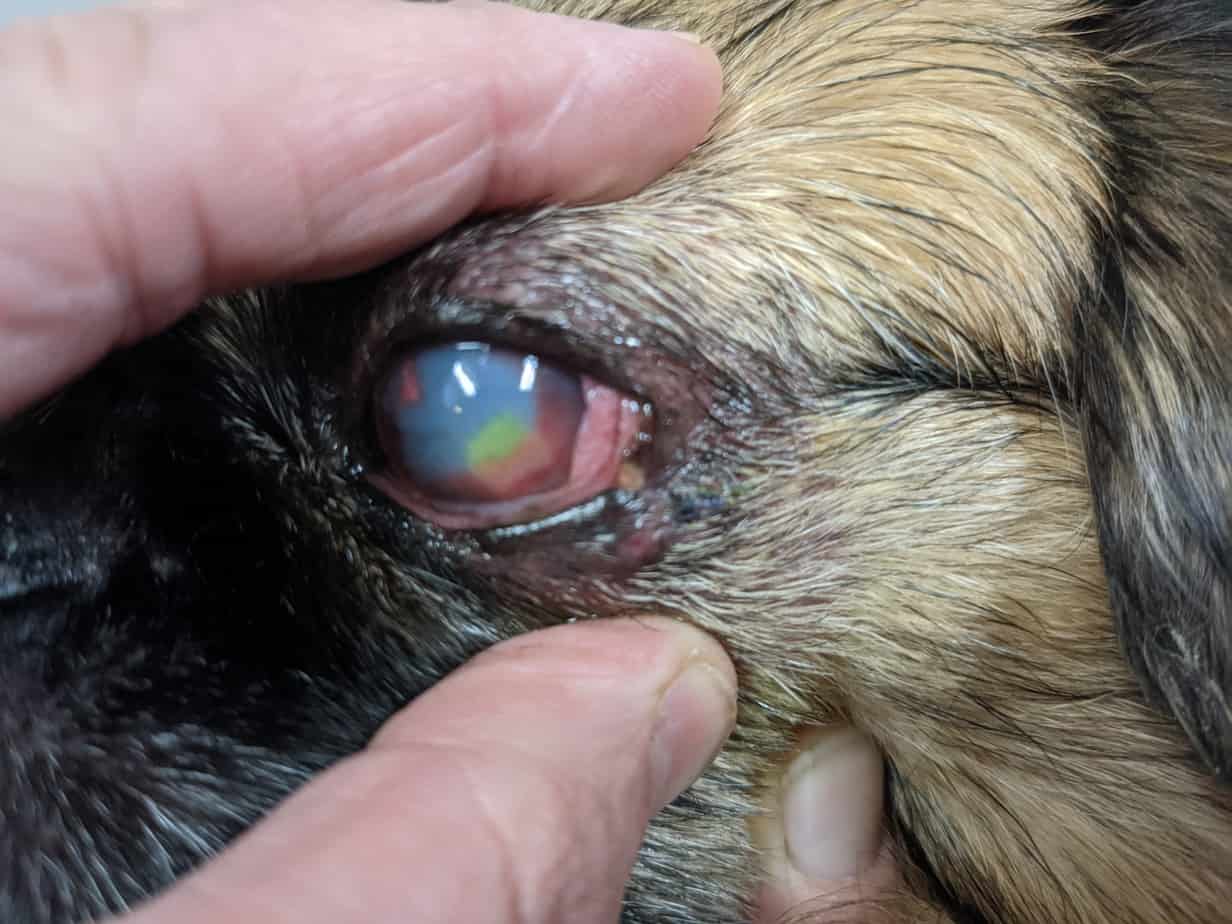Does My Dog Have A Corneal Ulcer?
Most dog owners who think that their dog has a corneal ulcer are probably right. If they’re acting painful around their eye and holding it closed, it’s definitely an issue that needs to be addressed. Left untreated corneal ulcers can cause a lot of pain and potentially result in the loss of the eye. Fortunately most of them are easily treated.
Table of Contents
What Is A Corneal Ulcer?
Any break or interruption in the surface of the cornea is considered an ulcer.
How Do Dogs Get Corneal Ulcers?
Dogs almost always get corneal ulcers from some sort of trauma to the eyes. That can be a scratch from another animal or just running into a bush. It can also occur following any surgery around the eye if the dog rubs on their face following the surgery (see the case below).
In my veterinary practice, the general rule is that if a dog is holding its eye closed it needs to be seen right away. The longer the eye goes with a problem, the worse that problem can get.
What Are The Symptoms Of A Corneal Ulcer?
- Keeping the affected eye closed a lot
- Pawing at the eye
- Lots of discharge (usually colored like a green or a gray)
- The cornea itself, instead of being clear, has a film of white or grey on it
- You may see tiny little red vessels coming from the outside of the cornea; this is the body’s attempt to bring the nutrients needed to heal an ulcer;
Example Of A Healing Corneal Ulcer

In the above photo, the following things are happening:
- The green/yellow on the eye is where the fluoroscein stain stuck to the ulcer to show you how big it is
- The red area that overlaps the ulcer and extends over the bottom 1/4 of the eye is new blood vessel growth; this is excellent – it means that the body recognizes the ulcer and is actively healing it
- The remainder of the cornea is blue/grey and this is just related to the fact that the cornea is generally inflammed because of the ulcer
- There’s a small defect in the lower eyelid where a small eyelid mass was removed. The suture that was present was the cause of the ulcer in the first place. Based on the fact that the suture was missing when I first saw this dog and that the entire lower lid was swollen, my assumption was that the owner wasn’t keeping the protective cone on the dog after surgery. This was indeed the case.
How Does A Corneal Ulcer In A Dog Get Better?
For most small, uncomplicated ulcers (those that are less than 1 mm) in size, they should heal within a week without any help. I will usually prescribe a topical antibiotic and, possible, a topical pain medication if I feel that it is needed.
If the underlying cause of the ulcer isn’t addressed, the healing will take longer. I’ve seen some ulcers take upwards of a month or two to heal when they are deep or when they have complications.
What If My Dog’s Corneal Ulcer Isn’t Healing?
Two main reasons why a dog’s corneal ulcer isn’t healing are:
- Indolent Ulcer
- Underlying ulcer cause hasn’t been addressed
Indolent Ulcer
There is a condition called an Indolent Ulcer that occurs in certain breeds. The quick explanation is that there are certain dog breeds (Boxers are notorious for this) that have a cornea that doesn’t seem to know when the cornea has been damaged. The ulcer just sits there for weeks and doesn’t get any smaller and nothing is happening around the eye. There’s no vessel growth and likely no change to the color of the cornea. Your vet puts the special stain on and it’s the same size week after week.
What I Do When An Ulcer Is Indolent:
- Apply topical anesthetic liberally
- Dry debridement of the ulcer to remove any soft, unhealthy cornea
- I then do a grid keratotomy – this is where I deliberately scratch a superficial pattern over the ulcer in a grid both horizontally and vertically across the entire ulcer. The grooves created by the deliberate scratches allow for a deeper purchase for new corneal cells to hold onto as the ulcer heals from the outside of the eye towards the ulcer.
- I give this first keratotomy at least 2 weeks before I consider any additional treatment. The most stubborn cases might need two procedures.
Underlying Issue
Any ulcer that looks like it’s properly trying to heal but just can’t either is still having repetitive trauma to that eye (are they wearing a cone??) or doesn’t have enough moisture to keep the newly healed ulcer healthy.
Not having enough moisture is called Dry Eye (aka Keratoconjunctivitis Sicca) and can be easily treated in its mild forms by applying extra moisture in the form of an eye wash (usually comprised of purified water) multiple times a day. In the more difficult cases to treat, other medications need to be used to try and nurse those tear glands to better production.
When To See A Specialist For A Corneal Ulcer
A Veterinary Ophthalmologist should be consulted whenever a corneal ulcer goes deeper and becomes a descemetocele. To save the eye/vision, immediate action may be needed. A descemetocele will look like an actual hole in your dog’s eye. If you see this and/or any actual fluid escaping from that hole, your dog needs to be seen immediately. This is an emergency.
